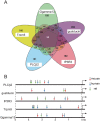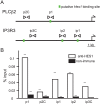Combined in silico and in vivo analyses reveal role of Hes1 in taste cell differentiation
- PMID: 19343206
- PMCID: PMC2655725
- DOI: 10.1371/journal.pgen.1000443
Combined in silico and in vivo analyses reveal role of Hes1 in taste cell differentiation
Abstract
The sense of taste is of critical importance to animal survival. Although studies of taste signal transduction mechanisms have provided detailed information regarding taste receptor calcium signaling molecules (TRCSMs, required for sweet/bitter/umami taste signal transduction), the ontogeny of taste cells is still largely unknown. We used a novel approach to investigate the molecular regulation of taste system development in mice by combining in silico and in vivo analyses. After discovering that TRCSMs colocalized within developing circumvallate papillae (CVP), we used computational analysis of the upstream regulatory regions of TRCSMs to investigate the possibility of a common regulatory network for TRCSM transcription. Based on this analysis, we identified Hes1 as a likely common regulatory factor, and examined its function in vivo. Expression profile analyses revealed that decreased expression of nuclear HES1 correlated with expression of type II taste cell markers. After stage E18, the CVP of Hes1(-/) (-) mutants displayed over 5-fold more TRCSM-immunoreactive cells than did the CVP of their wild-type littermates. Thus, according to our composite analyses, Hes1 is likely to play a role in orchestrating taste cell differentiation in developing taste buds.
Conflict of interest statement
The authors have declared that no competing interests exist.
Figures






Similar articles
-
Notch-associated gene expression in embryonic and adult taste papillae and taste buds suggests a role in taste cell lineage decisions.J Comp Neurol. 2003 Sep 8;464(1):49-61. doi: 10.1002/cne.10787. J Comp Neurol. 2003. PMID: 12866128
-
Multiple roles of Notch signaling in the regulation of epidermal development.Dev Cell. 2008 Apr;14(4):594-604. doi: 10.1016/j.devcel.2008.01.017. Dev Cell. 2008. PMID: 18410734
-
Expression of GAD67 and Dlx5 in the taste buds of mice genetically lacking Mash1.Chem Senses. 2014 Jun;39(5):403-14. doi: 10.1093/chemse/bju010. Epub 2014 Mar 28. Chem Senses. 2014. PMID: 24682237
-
Notch-Hes1 pathway contributes to the cochlear prosensory formation potentially through the transcriptional down-regulation of p27Kip1.J Neurosci Res. 2009 Dec;87(16):3521-34. doi: 10.1002/jnr.22169. J Neurosci Res. 2009. PMID: 19598246
-
Expression dynamics and functions of Hes factors in development and diseases.Curr Top Dev Biol. 2014;110:263-83. doi: 10.1016/B978-0-12-405943-6.00007-5. Curr Top Dev Biol. 2014. PMID: 25248479 Review.
Cited by
-
A Mechanistic Overview of Taste Bud Maintenance and Impairment in Cancer Therapies.Chem Senses. 2021 Jan 1;46:bjab011. doi: 10.1093/chemse/bjab011. Chem Senses. 2021. PMID: 33693542 Free PMC article. Review.
-
Anterior and Posterior Tongue Regions and Taste Papillae: Distinct Roles and Regulatory Mechanisms with an Emphasis on Hedgehog Signaling and Antagonism.Int J Mol Sci. 2023 Mar 2;24(5):4833. doi: 10.3390/ijms24054833. Int J Mol Sci. 2023. PMID: 36902260 Free PMC article. Review.
-
Bmp signalling in filiform tongue papillae development.Arch Oral Biol. 2012 Jun;57(6):805-13. doi: 10.1016/j.archoralbio.2011.11.014. Epub 2011 Dec 18. Arch Oral Biol. 2012. PMID: 22186069 Free PMC article.
-
Developing and regenerating a sense of taste.Curr Top Dev Biol. 2015;111:401-19. doi: 10.1016/bs.ctdb.2014.11.012. Epub 2015 Jan 20. Curr Top Dev Biol. 2015. PMID: 25662267 Free PMC article. Review.
-
Developing a sense of taste.Semin Cell Dev Biol. 2013 Mar;24(3):200-9. doi: 10.1016/j.semcdb.2012.11.002. Epub 2012 Nov 24. Semin Cell Dev Biol. 2013. PMID: 23182899 Free PMC article. Review.
References
-
- Spielman AI. Chemosensory function and dysfunction. Crit Rev Oral Biol Med. 1998;9:267–291. - PubMed
-
- Chandrashekar J, Hoon MA, Ryba NJ, Zuker CS. The receptors and cells for mammalian taste. Nature. 2006;444:288–294. - PubMed
-
- Beites CL, Kawauchi S, Crocker CE, Calof AL. Identification and molecular regulation of stem cells in the olfactory epithelium. Exp Cell Res. 2005;306:309–316. - PubMed
-
- Kelley MW. Hair cell development: commitment through differentiation. Brain Res. 2006;1091:172–185. - PubMed
-
- Limb GA, Daniels JT, Cambrey AD, Secker GA, Shortt AJ, et al. Current prospect for adult stem cell-based therapies in ocular repair and regeneration. Curr Eye Res. 2006;31:381–390. - PubMed
Publication types
MeSH terms
Substances
LinkOut - more resources
Full Text Sources
Molecular Biology Databases

